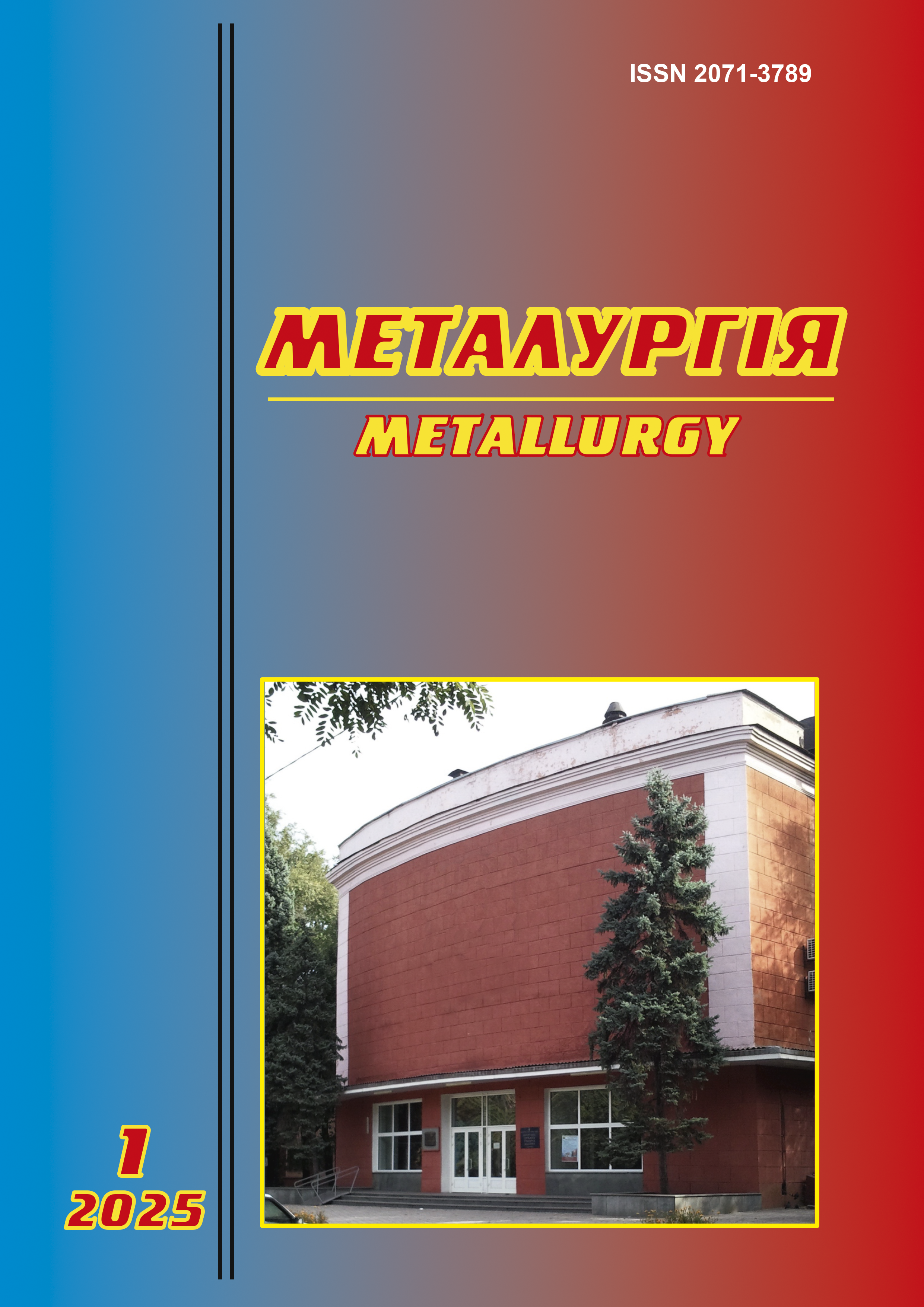DETERMINATION OF ENERGY PARAMETERS OF THE WIRE DRAWING PROCESS THROUGH DOUBLE DRAWINGS
Abstract
This study focuses on determining the wire drawing tension when the wire is pulled through double dies arranged in series without any intermediate storage devices. Significant wear of the drawing dies (spindles) is observed in the production of small-section wire by cold drawing. This leads to deviations in the finished profile in terms of both shape and size.To address this issue, it is necessary to improve the drawing technology by implementing measures to reduce die wear. To achieve this, technical and technological production factors must be considered.The main ways to increase the service life of the drawing tool are: using new wear-resistant materials to produce dies; reducing friction in the deformation zone using new lubricants and ensuring a stable lubricant supply; using vibration drawing and drawing with counter tension; ensuring an effective cooling process for the dies; using equipment to prepare the wire for drawing; and improving the drawing process.The main objective of this study is to analyse the stress-strain state of the metal during wire drawing with counter-tension, created by additional (rough) drawing. These studies will facilitate the development of rational drawing routes, reduce drawing wear and increase process productivity.Traditional wire production methods usually do not involve the use of counter-tension in finishing operations. An exception is direct-flow drawing mills that operate with counter- tension. On these drawing mills, counter-tension is created by adjusting the speed of the drawing drums. However, using counter-tension on other types of drawing mill will significantly impact the technical and economic performance of production.The results of the study show that using counter-tension during wire drawing creates additional tensile stresses in the metal. Creating elastic and elastic-plastic deformations from counter-tension reduces compressive stresses in the friction zone.
References
2. Vega G., Haddi A., Imad A. Investigation of process parameters effect on the copper-wire drawing. Materials & Design. 2009. Vol. 30, no. 8. P. 3308–3312. URL: https://doi.org/10.1016/j.matdes.2008.12.006
3. Simulation of a copper micro-wire drawing for electronics / A. V. Volkov et al. IOP Conference Series: Materials Science and Engineering. 2019. Vol. 537. P. 032054. URL: https://doi.org/10.108 8/1757-899x/537/3/032054
4. Fabrication of wire drawing machine / Nihal Kumar Dasoju et al. International Journal of Science and Research Archive. 2023. Vol. 9, no. 2. P. 123–134. URL: https://doi.org/10.30574/ijsra.2023.9.2.0507
5 Experimental Measurements of System Dynamics Between Two Stages of Wire Drawing Machine / G. Tasevski et al. Archive of Mechanical Engineering. 2015. Vol. 62, no. 1. P. 61–72. URL: https://doi.org/10.1515/meceng-2015-0004
6. Experimental Determination and Calculation of the Wire Drawing Force in Monolithic Dies on Straight-Line Drawing Machines / L. V. Radionova et al. Machines. 2023. Vol. 11, no. 2. P. 252. URL: https://doi.org/10.3390/machines11020252
7. Підвищення ефективності технологічних процесів волочіння і прокатки в умовах раціонального використання сил сухого і напіврідинного тертя під впливом зовнішніх вібрацій / Ю. Маліновський та ін. Problems of Friction and Wear. 2024. № 1(102). С. 101–125. URL: https:// doi.org/10.18372/0370-2197.1(102).18434
8. Грибков Е. П., Малигін С. О., Бережна О. В. Математичне моделювання напружено-деформованого стану під час волочіння порошкового дроту з металевим сердечником. Обробка матеріалів тиском. 2024. № 1(53). С. 34–42. URL: https://doi.org/10.37142/2076-2151/2024-1(53)34
9. Tribological performance of modified graphene as an additive in copper wire drawing lubricant / X. Lang et al. Industrial Lubrication and Tribology. 2025. URL: https://doi.org/10.1108/ilt-10-2024-0399
10. Experimental-numerical analysis to determine the efficiency of industrial lubricants in wire drawing process / T. Gomes dos Santos et al. Revista de Metalurgia. 2023. Vol. 59, no. 1. P. e234. URL: https://doi.org/10.3989/revmetalm.234
11. Trukhanovich A. A., Ledneva A. A. Lubricants for dry wire drawing. Steel in Translation. 2009. Vol. 39, no. 6. P. 510–511. URL: https://doi.org/10.3103/s0967091209060187
12 Tang Q. S., Yang Y. H. Fabrication and Application of CVD Diamond-Coated Copper Wire Drawing Die. Advanced Materials Research. 2011. Vol. 328-330. P. 1182–1187. URL: https://doi.org/10.4028/www.scientific.net/amr.328-330.1182
13. Lo S.-W., Lu Y.-H. Wire drawing dies with prescribed variations of strain rate. Journal of Materials Processing Technology. 2002. Vol. 123, no. 2. P. 212–218. URL: https://doi.org/10.1016/s0924-0136(02)00033-x
14 Yang X. Friction and wear behaviors of al2o3-based ceramic composite using as wire drawing dies. Chinese Journal of Mechanical Engineering. 2006. Vol. 42, supp. P. 121. URL: https://doi.org/10.3901/jme.2006.supp.121
15. Добров И. В. Новый метод определения коэффициента трения при волочении // Металлургическая и горнорудная промышленность. 2000. № 4. С. 51-54.
16. Experimental study on titanium wire drawing with ultrasonic vibration / S. Liu et al. Ultrasonics. 2018. Vol. 83. P. 60–67. URL: https://doi.org/10.1016/j.ultras.2017.08.003
17.Ultra-fine high-carbon steel wire drawing with ultrasonic vibration / H. Cao et al. IOP Conference Series: Materials Science and Engineering. 2019. Vol. 531. P. 012027. URL: https://doi.org/10.1088/1757-899x/531/1/012027
18. Перлин И.Л. Ерманок М.З. Теория волочения. Металлургия, 1971. 447 с.
19. Добров И.В., Гарнави Н.Я., Гарнави О.Н. Математическое моделирование формоизменения пластического материала в конусном калибре // Теория и практика металлургии, 2000. № 3.С. 53-56.
20. Ніколаєв В. О. Теорія волочіння металу. Навчальний посібник. – Запоріжжя, ЗДІА, 2000. 155с.
21. Troost Alex, Akin Okan, Boffin Reinhold. Zi ehkraft foumeln beim Drahf ziehenl // Draht. 1992. № 9. Р. 732 – 735
22. Тарнавский А.Л. Эффективность волочения с противонатяжением. – М.:Металлургия, 1959. 151с.
23. Теория волочения сплошных профилей. Учебное пособие / Ю.О. Зыков. – Киев: УМК ВО, 1991. 116с.
24. G. D. S. McLellan.// Journal of the Iron and Steel Institute. 1948, 158. № 111. P. 347-356.

 ISSN
ISSN 


